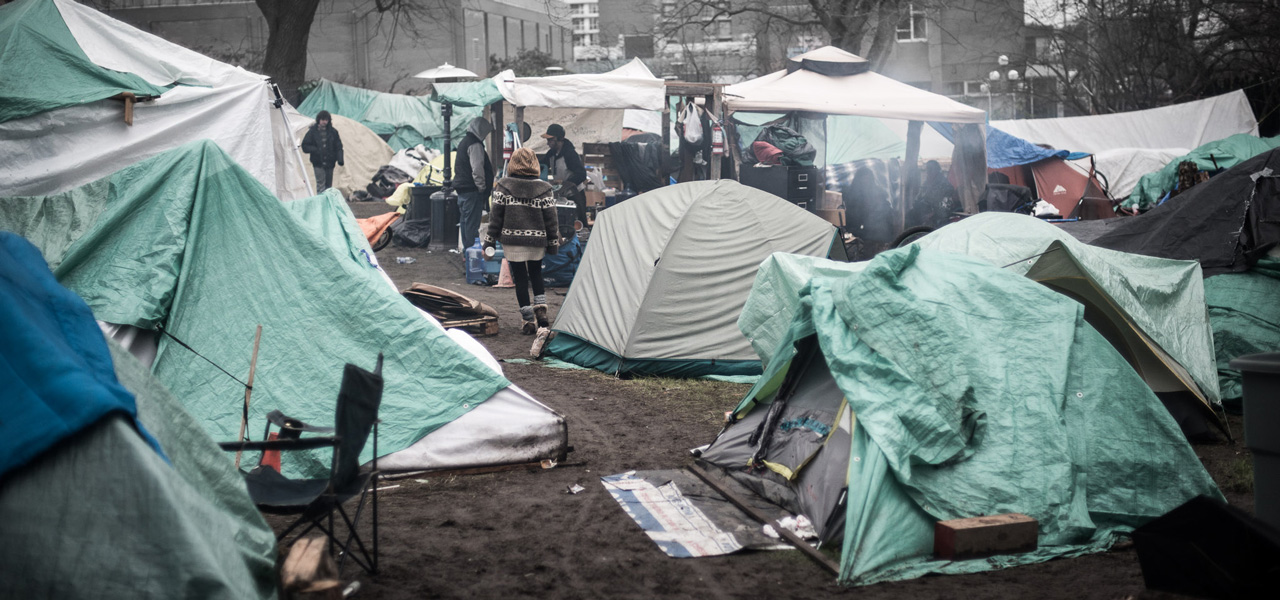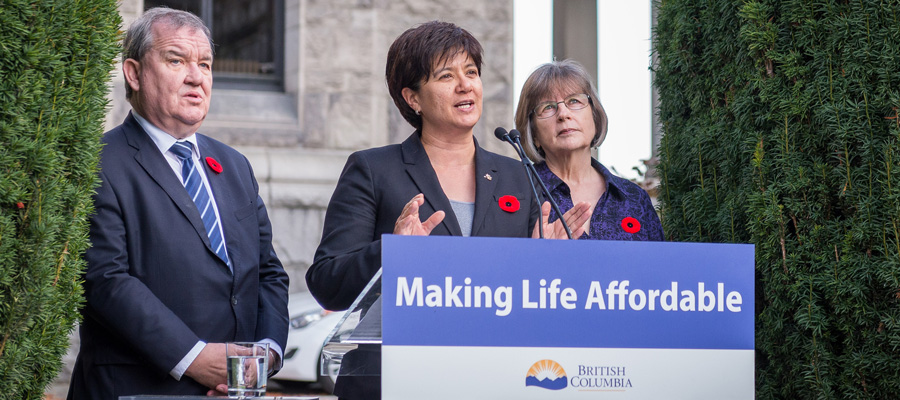Five ways BC Budget 2019 could pave the way for a comprehensive poverty reduction plan
In a province where poverty was ignored for too long, BC’s current government deserves credit for finally making poverty reduction a priority.
BC’s first-ever provincial poverty reduction strategy is coming later this spring. It will set out the framework for action to achieve the government’s legislated targets to reduce the overall poverty rate by at least 25 per cent and child poverty by at least 50 per cent in five years.
The need is clear: BC has some of the highest levels of poverty in Canada. Tolerating poverty and homelessness is unfair and unnecessary in a wealthy country like ours. It is also very expensive because we all pay for the negative consequences of poverty and homelessness. The CCPA has calculated that poverty costs BC between $8.1 and $9.2 billion annually in higher costs to the criminal justice system, lost productivity, lower school success and higher health costs.
The BC government has already taken steps to assist low-income residents, including a modest increase in welfare and disability rates in September 2017 (breaking a 10-year freeze for the former), a schedule to raise the minimum wage to $15/hour, and measures to improve access to child care, housing, dental care and prescription drugs for lower-income families. A panel of academics has been appointed to study basic income and whether and how it could work in BC.
While these represent a solid start, significant new measures are needed to achieve the targets outlined in the new Poverty Reduction Strategy Act.
To set the strategy up for success, BC’s provincial budget—which will be tabled before the strategy itself—must include substantial new investments to tackle both the breadth and the depth of poverty.
Here are five new investments that we need to see in BC Budget 2019 to deliver a poverty reduction plan that is bold and ambitious, and that will stand the test of time.
1. Immediate increases to social assistance and disability rates
We believe that BC’s poverty reduction strategy must include measures to reduce deep poverty and eliminate the most extreme and severe forms of poverty, such as homelessness and hunger. While reducing the depth of poverty was not one of the legislated targets embedded in the new Act, it would be unconscionable for a government committed to poverty reduction to risk leaving the poorest and most vulnerable British Columbians behind.
The goal we have long advocated for, as has the BC Poverty Reduction Coalition, is to ensure all British Columbians have incomes that reach at least 75% of the official poverty line in two years (75% of the poverty line is also how the federal government defines deep income poverty in Canada’s new federal poverty reduction strategy).
To achieve this goal, BC must significantly increase welfare and disability rates over the next two years. In the medium term, income assistance rates must be set at a level that meets actual costs of living in this province—above the poverty line at a minimum—and be indexed to inflation to ensure that long freezes do not erode their value over time.
Currently, annual income for those on social assistance ranges from about 43% of the poverty line for people without children in the “expected to work” category to 68% of the poverty line for a single person on disability assistance to 71% of the poverty line for a single parent with one child.
By keeping welfare incomes too low (and forcing people to virtually exhaust their savings before they can even qualify for assistance), the system makes it extremely difficult to transition to work.
For a single person in the “expected to work” category (those furthest below the poverty line, and the second largest group of welfare recipients), this would mean increasing monthly assistance by approximately $548.
We have estimated that the cost of getting all social assistance recipients to 75 per cent of the official poverty line—and essentially eliminating deep poverty—would be approximately $365 million a year, which is less than one per cent of the annual provincial budget.
By keeping welfare incomes too low (and forcing people to virtually exhaust their savings before they can even qualify for assistance), the system actually makes it extremely difficult to transition to work. As we documented in our report the CCPA report Living on Welfare in BC, inadequate benefits drive recipients to spend much of their time focused on survival (e.g., lining up for free food). As well, it’s virtually impossible to connect with potential employers when you are unable to afford transit, let alone a car, work clothes, Internet or a phone.
2. New investments in low-income housing
The 2017 September BC Budget Update invested in 2,000 new modular housing units, which are set to make a difference in some vulnerable people’s lives. These units are envisioned as an interim solution to allow time for permanent housing solutions to be developed.
But we need to keep the momentum going.
The need is dire: last year’s province-wide homeless count identified nearly 7,700 homeless persons—and that number is widely seen as an underestimate. In addition to building new housing stock to house the homeless, BC Budget 2019 must provide stable, long-term funding for the staffing and support services that residents need to live with dignity.
To successfully tackle the homelessness crisis in our province, and fulfill its election commitment of 114,000 units over 10 years, the BC government must invest in a large-scale expansion of social and co-op housing over and above what has already been announced. Investment is needed to increase supply along a continuum of affordable rental housing options to meet the broad range of housing need—from extremely low-cost supportive housing for the homeless and those with complex health needs and addictions, to below-market social housing for low-income working families, to low-cost housing for women and children fleeing domestic violence and sexual abuse, Indigenous people, seniors and new immigrants and refugees.
Aside from building housing supply, the BC government has already made some changes to the Residential Tenancy Act to better protect vulnerable tenants and is considering additional reforms put forward by the Rental Housing Task Force. BC Budget 2019 needs to include sufficient funds for the Residential Tenancy Branch to ensure these reforms can be meaningfully enforced.
You can read more details about our broader recommendations for affordable housing here.
3. Funding for better social assistance delivery
A comprehensive poverty reduction strategy requires measures to foster a culture of dignity and respect for marginalized people in order to combat social exclusion. This must start with the way government provides services to the most vulnerable British Columbians.
Seeking social assistance should not harm a person’s dignity. Yet the current process is stigmatizing and rife with administrative barriers that discourage, delay and deny access to social assistance to British Columbians who need support. Years of persistent underfunding in the Ministry of Social Development have made it increasingly difficult to seek support, as documented in a recent policy brief from the BC Poverty Reduction Coalition.
Seeking social assistance should not harm a person’s dignity. Yet the current process is stigmatizing and rife with administrative barriers that discourage, delay and deny access to social assistance to British Columbians who need support.
Budget 2019 must invest in service delivery to simplify the complex online application process for social assistance, make the application form available in languages other than English, hire additional Ministry staff to reduce wait times on BC’s social assistance phone line, and restore access to in-person application assistance by re-opening Ministry offices where they have been closed.
In addition, the successful Single Parent Employment Initiative should be extended to permit all income assistance recipients to receive benefits while enrolled in full-time post-secondary education or training programs, in order to help those who are able to work to break the cycle of poverty.
4. Funding for timely, proactive enforcement of employment and labour law
Employment standards and labour laws are the basic terms and conditions of employment below which employers are not permitted to go. They cover a number of aspects of work, including minimum pay, the right to safe and healthy workplace, and the right to have a union and collectively bargain if workers choose to do so. Employment and labour laws exist to protect individual employees from exploitation but also aim to ensure reasonable conditions of work and a decent standard of living for all workers.
These basic workplace rights are particularly important for vulnerable workers such as new immigrants, young workers, low-wage workers, women, workers of colour and those employed in more precarious sectors—all of whom are less able to secure workplace conditions better than the minimum requirements laid out in the law.
Unfortunately, for too many vulnerable workers in our province today, workplace rights exist only on paper. The key enforcement bodies for provincial workplace rights—the Labour Relations Board and the Employment Standards Branch of the Ministry of Labour—have been underfunded to a point where they cannot adequately administer and enforce the law. This severely undermines access to justice for vulnerable workers, as outlined in our submissions to the employment standards and labour relations code review processes.
We recommend increased funding for the Employment Standards Branch of the Ministry of Labour to be able to investigate individual complaints in a timely manner (and abolish the current, ineffective self-help kit) and begin proactive enforcement of the employment standards, with a particular focus on specific industries and types of workplaces that are known for their non-compliance. In addition, increased funding for the Labour Relation Board is needed to ensure that it can investigate complaints and ensure the laws are enforced.
5. Investments in access to justice for lower-income and marginalized communities
Ever since funding for legal aid family law services was cut by 60% in the early 2000s, legal aid has been persistently underfunded, leaving lower-income women and children, and otherwise marginalized people to navigate the justice system alone or hope for a lawyer to take their case on a pro bono basis.
We recommend increased funding for legal aid (as have others) and specifically, funding to expand family law, poverty law and First Nations legal services. This would tremendously improve access to justice for women and people living in poverty.
Funding for legal aid family law services was cut by 60% in the early 2000s, and marginalized people have had to navigate the justice system alone or hope for a lawyer to take their case on a pro bono basis.
In addition, Budget 2019 should build on last year’s small increase of funding for community-based programs and services supporting women and children affected by violence (including counselling, outreach and crisis assistance) and provide additional, stable funding for the sector. Since the #MeToo campaign, local service providers have seen an unprecedented increase in the number of women coming forward and are struggling to keep up with the current level of funding. (For more details, see the Ending Violence Association of BC’s recent policy brief).
***
In addition to these five priority investments, a comprehensive poverty reduction plan requires that we:
- Expand access to affordable dental and eye care, as well as pharmacare for low-income people, including both the working poor and those on social assistance. Gaps in coverage of these services, even for those with supplemental health coverage under welfare and disability assistance, were highlighted in the report capturing the feedback from the public consultation on poverty reduction;
- Increase funding for community health services for seniors, people with disabilities, and those with mental health illnesses and addictions. Gaps in access for these services put pressure on the most expensive component of the health care system—emergency rooms and hospitals—costing BC more in the long term;
- Invest in making public transit more accessible and more affordable, for example by funding free transit for children and youth as proposed by the #AllOnBoard, BC currently provides a virtually free bus pass (at the cost of $45 per year) to persons receiving disability assistance, and certain low-income seniors, including welfare recipients who are 60 or older, but not to younger social assistance recipients or the working poor;
- Improve access to education and training for low-income people (including more generous financial support for lower-income students in colleges and universities) and improve services for special needs students in the K–12 education system;
- Invest in programs that tackle poverty among populations and communities where poverty is most acute, including Indigenous people, new immigrants and refugees, people of colour, single-parent families (and particularly, single-mother families), single seniors (particularly women), people with disabilities, people with mental health or addiction issues, queer and trans folks (especially youth), and others; and
- Continue to boost investment in child care, moving towards the goal of building a universal, affordable and quality public child care system modelled after the widely endorsed $10-a-Day Child Care Plan.
BC’s first-ever poverty reduction strategy is an opportunity for this government to change vulnerable people’s lives for the better and strengthen our communities and our economy. To succeed, the strategy must be, as the BC Poverty Reduction Coalition puts it, “accountable, bold and comprehensive,” and BC Budget 2019 must provide the investments required to meaningfully implement it.
The good news is that BC has the economic and fiscal capacity to reduce poverty on a fast timeline and to exceed the legislated targets. Even better, many of the recommendations outlined above would raise the incomes of those at the bottom of the income ladder—a group of people who spend their income purchasing goods and services locally (because they don’t have the luxury of saving)—and thus, would provide a welcome economic boost to communities across the province.
Topics: Employment & labour, Features, Housing & homelessness, Poverty, inequality & welfare, Provincial budget & finance







